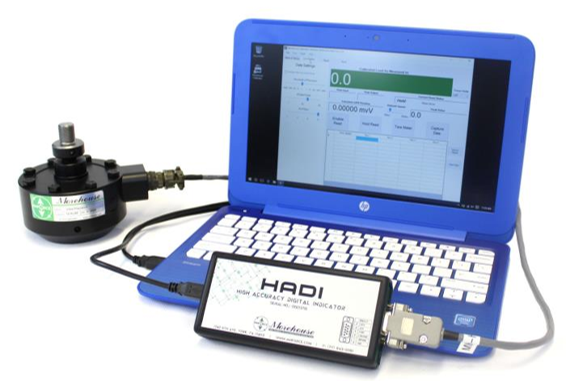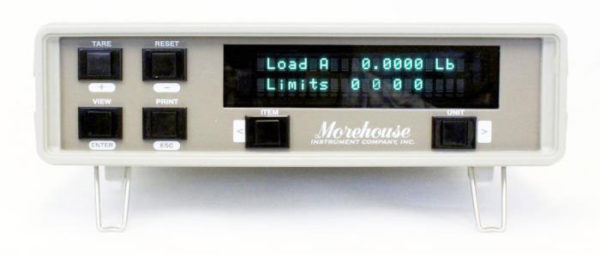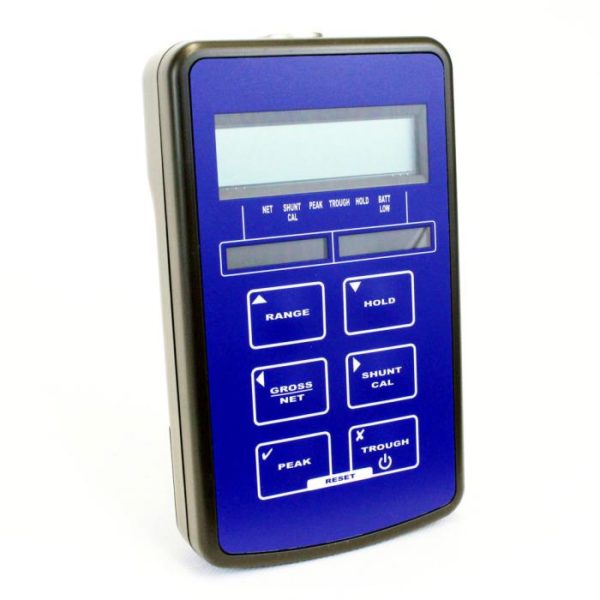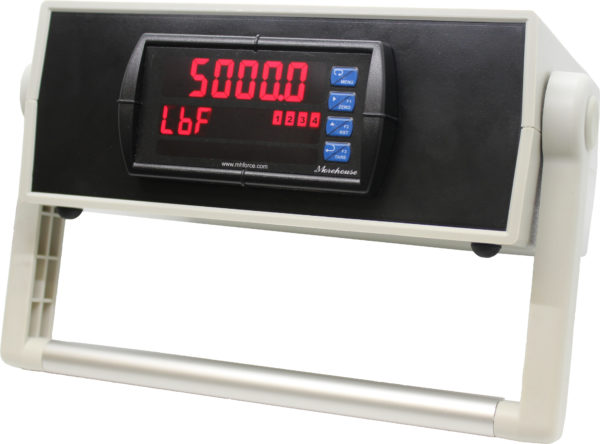Load Cell Indicator Basics
In the last Back-to-Basics blog, I covered Load Cell Troubleshooting. As I continue to cover basic concepts for beginners, this blog covers the basics of a load cell indicator.

Morehouse High Accuracy Digital Indicator (HADI)
When force is exerted on a load cell, the mechanical energy is converted into equivalent electrical signals. The load cell signal is converted to a visual or numeric value by a "digital indicator." When there is no load on the cell, the two signal lines are at equal voltage. As a load is applied to the cell, the voltage on one signal line increases very slightly, and the voltage on the other signal line decreases very slightly. The indicator reads the difference in voltage between the two signals that may be converted to engineering or force units.
There are several types of indicators available, and they have different advantages and disadvantages. The decision for which indicator to use should be based on what meets your needs and has the best non-linearity and stability specifications.

Morehouse 4215 Indicator
Non-linearity and Uncertainty Specifications
The specification that most users look for in an indicator is the non-linearity. The better the non-linearity is, the less the indicator will contribute to the system uncertainty.
Some indicators on the market may specify accuracies in terms of percentage of reading. Although these may include specifications such as 0.005 % of reading, they can cause negative impacts on the system's uncertainty. The problem is that the resolution or number of digits may be such that the specification will not be maintained. Morehouse has a new (2020) high stability 4215 indicator pictured above with 0.002 % non-linearity specification. The Morehouse 4215 meter will display up to 5 decimals in mV/V, which equates to a resolution of between 200,000 to 400,000 counts on the most common load cells.
In other cases, the indicator may require adjustment at various span points to achieve non-linearity between span points that they are substituting an overall accuracy specification. Generally, the purpose of multi-spanning the range in an indicator is to divide the sensor output range into smaller segments and reduce non-linearity errors. However, accuracy claims can be questionable. Ensure the accuracy specification includes stability over time, repeatability, non-linearity, temperature characteristics, and consideration of the resolution or avoid this type of indicator.
Non-linearity errors in a load system can be drastically reduced by:
- Employing the right calibration and measurement process
- Pairing a highly stable indicator to the load cell
- Having the system calibrated to highly accurate standards such as Primary Deadweight Standards
- Using ASTM E74 or ISO 376 calibration coefficients to convert load cell output values into force units.
This can be achieved using a Morehouse HADI or 4215 indicators in conjunction with the Morehouse calibration software, which is included with the indicator. When comparing non-linearity, the HADI has better than 0.002 % of full scale, the 4215 has better than 0.005 % of full scale, and the PSD has better than 0.005 % of full scale.
Stability and Drift
This characteristic is often more difficult to quantify on non-high-end multimeters. Some indicators will specify thermal drift, long-term stability of zero, and some will have an actual stability per range. The indicators that are often over $10,000 will fall into specifying drift at different intervals such as 90 days and one year. Most indicators under $2,500 are not going to address 90 days or 1-year stability specifically. Stability can be monitored and maintained by a load cell simulator. However, a user can choose to live with the entire system drift of the load cell and indicator combined.
The $10,000 plus indicators from Agilent, Keysight, and Fluke win in this category, but these are not portable and are often overkill for general application force systems. The Morehouse HADI with the long-term stability of zero at 0.0005 %/year at room temperature is an excellent choice for under $1,000.00.
Resolution
If you are using the indicator as a field system, a stable resolution of greater than 50,000 counts over the load cell's output range will allow higher-order fits. It is also desirable for ASTM E74 calibrations because a higher-order fit will generally yield a Lower Limit Factor (LLF) and better Class AA and Class A loading ranges. An excellent indicator to pair with your reference standard to calibrate other load cells is the Morehouse HADI as it can display 4.00000 mV/V stable to within 0.00001 mV/V on a good load cell. The Morehouse 4215 is the next best choice as it is typically stable to within 0.00002 mV/V.
Number of Span Points
This assumes you require the actual display to read in engineering units and are not okay with 4.00001 mV/V representing 10,000.0 force units such as lbf or kN. If you want the indicator to read 10,000.0 when 10,000.00 is applied and do not want to use a computer for the physical display, then the Morehouse 4215 with multiple span points and store coefficient files is an excellent choice.

Morehouse Gauge Buster 2 Indicator
Another very good option is the Morehouse/Admet Gauge Buster with High Stability option. The indicator comes standard with more than 10 point linearization. However, the downfall of any system set up for direct reading is that it cannot be maintained. As the system drifts, so will the readings. Therefore, 10,000.0 today may equate to 10,000.9 in a year. Consequently, we highly recommend having the output read in mV/V and converting it via software or internally. The Morehouse 4215 and HADI with the software are the best options if one would want drift corrected at the time of calibration.
Environmental Conditions
Specifications such as temperature effect on zero and temperature effect on span indicate the environmental effects. The Morehouse HADI is excellent in this category, with a typical 1 ppm per degree Kelvin and a max of 2 ppm.
Four or Six Wire Sensing
To learn more about the difference between a 4-wire and 6-wire system, read this blog. Generally, cable resistance is a function of temperature and length. A 4-wire system will have additional errors from temperature changes and from using different length cables. In fact, in most cases changing a cable will require calibration, while a 6-wire system will run sense lines separate from excitation and eliminate the effects due to these variations. The Morehouse 4215 and HADI are both 6-wire systems.
Required Load Cell Output
Some indicators cannot handle load cell output above 2.5 mV/V, creating problems with 3 mV/V and 4 mV/V load cells. Morehouse indicators such as the PSD, HADI, and 4215 handle load cells with output up to 4.5 mV/V.

Morehouse PSD Indicator
Ease of Use
This is a preference-based consideration. Some ease-of-use examples are eliminating the need for a computer or power supply. Or not having to use load tables and merely pushing the spacebar for the computer to grab readings. If you want something simple that does not need a power cord; the PSD is the winner. If you want a portable system that could run on laptop power and capture readings, the HADI is the winner.

Morehouse PD6100 Indicator
If one can use a power cord and wants a bit more in terms of span points, less cost, and less portability, we have a PD6100 indicator that provides a simple solution for one compression and tension-type load cell. There are multiple span points for each channel that can be programmed to get closer to the nominal value. This meter is a direct replacement and upgrade over some other meters on the market.
Ruggedness
The Morehouse HADI, PD6100, and PSD are enclosed and are a bit more durable than the 4215. The PSD, Admet, and PD6100 would be the hardest to break physically and would be the best choice for a very rugged environment where a computer cannot go.
Number of Load Cell Channels Required
If you want to use several load cells on the system, then the Morehouse 4215 or HADI can be used. If the requirement is to set each of these channels up to multiple span points, then the 4215 or the Morehouse/Admet Indicator would win.
Excitation Voltage
Some users may have a requirement to change the excitation voltage or have a specific requirement for a 10V dc excitation to be applied to the sensor. In this scenario, the Morehouse 4215 is the only choice.
Choosing the right indicator is many times a matter of personal preferences. The HADI indicator comes first for several selection criteria, but these may not be the criteria that matter for your individual needs. Choose the indicator that meets your needs with the best non-linearity and stability specifications. If you need a rugged, battery-powered indicator with at least 50,000 counts of the resolution, a PSD or PD6100 is an excellent choice. If you need a stable system and can carry a laptop with you, then the HADI may make the most sense. Finally, if you need a system where you must have a live display, use a computer, and need a 10V excitation source, 4215 would be a great option.
Our next Back-to-Basics blog will contain a glossary of terms commonly used in force measurement.
Back-to-Basics Series:
- Force Calibration and its Importance
- How a Transducer Measures Force
- Compression and Tension Force Calibration
- Calibration versus Verification
- Measurement Uncertainty
- Load Cell Terminology
- Types of Load Cells
- Load Cell Troubleshooting
- Load Cell Indicator Basics
- Force Measurement Glossary of Terms
I take great pride in our knowledgeable team at Morehouse, who will work with you to find the right solution. We have been in business for over a century and focus on being the most recognized name in the force business. That vision comes from educating our customers on what matters most, having the right discussions relating to force calibration basics so that everyone speaks the same language.
If you enjoyed this article, check out our LinkedIn and YouTube channel for more helpful posts and videos.
Everything we do, we believe in changing how people think about force and torque calibration. We challenge the “just calibrate it” mentality by educating our customers on what matters, and what causes significant errors, and focus on reducing them.
Morehouse makes simple-to-use calibration products. We build fantastic force equipment that is plumb, level, square, rigid and provide unparalleled calibration service with less than two-week lead times.
Contact us at 717-843-0081 to speak to a live person or email info@mhforce.com for more information.


